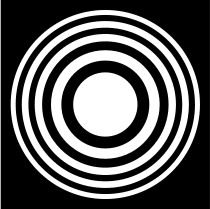Zone plates are used in photography in place of a lens or pinhole for a glowing, soft-focus image,and may be used as imaging lenses with a single focus, but how to model it, here it is!
A zone plate is a device used to focus light or other things exhibiting wave character. Unlike lenses or curved mirrors however, zone plates use diffraction instead of refraction or reflection. A suitable circular absorbing or phase grating is called Fresnel zone plate (FZP). A FZP focuses the incoming beam to a point focus . The minimum diameter of the focus reached is 15 nm for X-rays in 2008. There are also zone plates reflecting the incoming light.
A zone plate consists of a set of radially symmetric rings, known as Fresnel zones, which alternate between opaque and transparent. Light hitting the zone plate will diffract around the opaque zones. The zones can be spaced so that the diffracted light constructively interferes at the desired focus, creating an image there.

Let’s define a Fresnel Zone Plate Specs
Z=200mm
Wavelength: 1um
N=35
The design structure is as below:

The spacing of the rings is selected to block light from every other Fresnel zone, so that at a distance of 200.0 mm the light diffracted from all the zones interferes constructively. The constructive interference creates a bright focused spot on axis; an effect not predicted by ray tracing.


The zone plate was created by placing one annular obscuration on each of several surfaces; all located at the same plane. The option to “Use Rays To Propagate To Next Surface” is used to speed the computation through all the aperture surfaces.
To verify the focusing power, 66,66mm, 133.32, 199.98, 266.64, and 10000 positions to check its performance:
Distance @ 66.66

Distance @ 132

Distance @ 200

Distance @ 266

Distance @ 10000

About Near and Far Field
If the Fresnel number is small, less than roughly 1, then the beam at the observation point is said to be in the “far field” relative to the current beam.
For Fresnel numbers larger than 1, the beam at the observation point is said to be in the “near field” relative to the current beam.
And A perfectly collimated beam will have a Fresnel number given by

Which for Z greater than A reduces to approximately
![]()
Where A is the radial size of the beam and Z is the distance from the beam to the observation point. The Fresnel number becomes small as Z grows large.
For beams that are not collimated, the concept is the same. A converging beam will have a very small Fresnel number if the observation point is near focus. A perfectly spherical beam converging to focus will have a Fresnel number of zero, since there are no zones where the observed phase reaches π. As the observation point moves from the focal region, the Fresnel number increases.
In the design above:
Fresnel number @ 66mm is 107.7>>1, which is near field;
Fresnel number @ 132mm is 54>>1, which is near field;
Fresnel number @ 200mm is 35>>1, which is near field;
Fresnel number @ 10000mm is 0.71<1, which is near field.
It is important to consider the terms near and far as being relative to the propagation from the present location of the beam to the observation point at which the Fresnel number is computed, rather than having any rigid relationship to the beam position alone. For example, a beam in the exit pupil of an optical system is typically called the near field because the far field is at focus. However, a short propagation from focus to a slightly out of focus observation point is likely a near field propagation if the defocus is small.
The design file used in this example, please download it here. What is Fresnel imaging (Fresnel Zone Plate )
Reference Source:
- https://www.zemax.com/
- Zemax Optical Design Program User’s Guide, Zemax Development Corporation
- https://en.wikipedia.org/wiki/Main_Page
- http://www.x-ray-optics.de/index.php/en/types-of-optics/diffracting-optics/fresnel-zone-plates#Condenser_zone_plates


